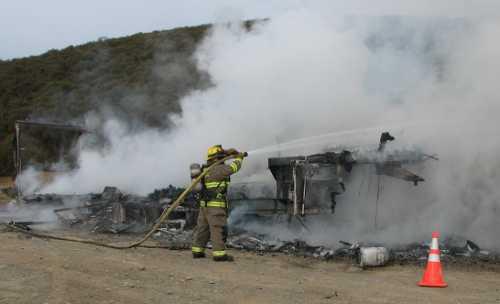- Elizabeth Larson
- Posted On
Repairs to south county chip seal project ended by weather
Caltrans had reported plans for International Surfacing Systems of West Sacramento to complete the pavement repairs on Highway 29 from the Lake/Napa County line to Hidden Valley Road. But the plans were first rained out late last month, then winter temperatures ended the work last week.
Caltrans spokesman Phil Frisbie the plan was to grind down to the main asphalt layer on a 1,000-foot stretch of highway.
“That's an area where the previous asphalt, the open grade asphalt, had been deteriorating,” leaving ruts in the area of tire tracks, Frisbie said.
“Unfortunately the chip seal doesn't fill in very much on those ruts” and they were just covered over, Frisbie said.
The idea with the proposed grinding was to make the ride smoother for drivers in advance of the spring repaving project that Caltrans has promised will take place in response to south county residents' complaints about the large, 1/2-inch aggregate chip seal and its impact on their cars.
Area residents also have argued that the road is no longer safe, as Lake County News has reported.
“I think it's an economic recovery act for the tire shops, because it does wear out your tires faster, there's no doubt about that,” said District 1 Supervisor Jim Comstock, who has been a critic of the work.
Originally, International Surfacing Systems was scheduled to conduct the repairs on Dec. 28 and 29.
However, Frisbie said the repairs were rained out then. They were then rescheduled to Jan. 4 and 5.
But that didn't work out either, with Frisbie reporting that the grinding had been suspended because the temperature had dropped too low to use a “fog seal” to seal the pavement after the grinding.
“Not sealing the pavement would allow gravel on the surface to work loose this winter and create more of a problem for drivers,” he said.
With the temperature not likely to go up before the spring, when the repaving is supposed to take place, Frisbie said all work has been suspended in the area for the time being.
International Surfacing Systems received a total of $2.1 million for the chip seal projects, which took place on 12 miles of Highway 29 from the Lake/Napa County lines to the Coyote Creek Bridge and 8.5 miles on Highway 175 from Cobb to Middletown.
The company would have received additional funds for the repair work, but won't now since the grinding project was canceled, Frisbie said.
In an October meeting with south county residents hosted by Comstock, Caltrans District 1 Director Charlie Fielder had guaranteed that the 20 miles of highway would be repaved.
Frisbie confirmed that the repaving project has funds committed to it from savings on other work.
“Most projects are coming in well under estimates due to competition among the contractors, and these leftover funds are funding additional projects statewide,” he said.
The California Transportation Commission will formally allocate the funds at its meeting on March 23 and 24, Frisbie added.
Comstock said residents of his district still aren't happy with the road work, although they're getting used to it.
He said he found Fielder “upfront,” adding, “he listened and he admitted that there was a problem. And he was the first one who did. Nobody else would.”
Although the grinding didn't happen, the highway was striped, Comstock said. The lack of striping had been another concern for drivers, who were having trouble seeing the lanes on the highway, according to statements at the October meeting.
International Surfacing Systems also is in discussions with the Lake County Air Quality Management District over settling a case involving fines the district assessed against the company for allegedly failing to get the proper air quality permits when conducting the chip seal project, as Lake County News has reported.
Air Pollution Control Officer Doug Gearhart previously estimated that the company's potential liability ranged between $825,000 and $2,475,000 for 33 alleged violations.
Gearhart said last week that he was waiting for the company to respond any day to the settlement agreement, which would allow total fines of less than 10 percent of the total liability.
E-mail Elizabeth Larson at This email address is being protected from spambots. You need JavaScript enabled to view it. . Follow Lake County News on Twitter at http://twitter.com/LakeCoNews , on Facebook at http://www.facebook.com/pages/Lake-County-News/143156775604?ref=mf and on YouTube at http://www.youtube.com/user/LakeCoNews .

 How to resolve AdBlock issue?
How to resolve AdBlock issue? 











